African violets are susceptible to a number of leaf problems. A common example is a leaf scorch. This condition can result from poor air circulation, low humidity, and a lack of proper nutrients.
It can also be caused by overexposure to bright, indirect sunlight. Fortunately, this problem can be easily remedied with proper watering.
1. African Violet Leaves Curling
Curled leaves in African violets can be caused by several factors. Sometimes, the leaves curl due to too much or too little sunlight. African violets need indirect light to grow properly. If they are exposed to direct sunlight, the leaves may turn brown and curl. Some plants will actively grow toward the nearest light source.
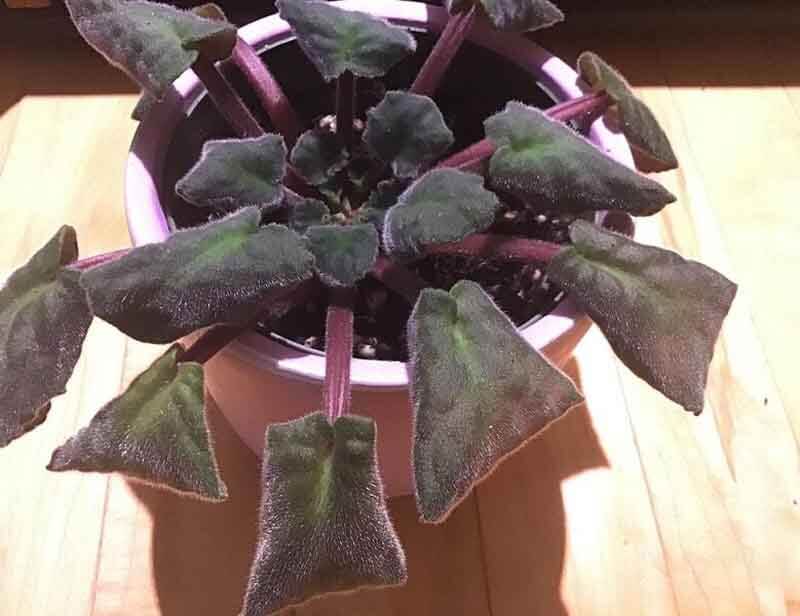
Another cause of African violet leaves curling is too much or too little water. If you are drowning your plant, it may be suffering from root rot. This can be minor or severe. In the milder cases, the plant may be saved by using a fungicide.
However, if the rot is too severe, the plant may die. To avoid this condition, water the plant only minimally at first and gradually increase the amount.
Insect infestation can also be a cause of the plant’s leaves curling. Insects can feed on new growth and destroy leaves. Mites may also cause the plant to bloom poorly or stunt. If you are not able to remove the infestation, you can try moving the plant to a warmer location or a shaded area. You can also use insecticides to control the mites.
Solution
To prevent leaf curling, give your African violet plant six hours of indirect light every day. Keep its soil moist but not too wet. This will prevent the plant from becoming stressed.
Also, water the plant as soon as you notice the soil feels less moist. Also, check for signs of pest infestation such as white spots or dots. If you suspect a pest infestation, treat the plant with neem oil or apply a spray of the same substance to the leaves.
Occasionally, you may notice your plant’s leaves curling due to dry soil or mites. You can also try keeping your plant hydrated with a humidifier or mist. Make sure the soil drains well.
Maybe you like: How Fast Does Ivy Grow? Facts You Should Know
2. African Violet Leaves Turning Brown
African violets are susceptible to a number of pests, which can cause their leaves to turn brown. These pests include aphids and mealybugs, which eat the sap from the plant’s leaves. Additionally, thrips scratch the leaves and can lead to brown spots. If you suspect that your plants are infested, you can spray them with an insecticidal soap or neem oil to kill the pests.
If your plant has brown leaves, you may have overfertilized it. Overfertilization can cause the leaves to turn brown, as does low relative humidity. To increase the humidity in the room, try a humidifier.

This will increase the humidity in the room and help prevent fungal growth. Adding dolomite lime to the soil twice a month can also help maintain the pH levels in the soil and improve root health.
Hard water contains high levels of minerals, which can build up on the leaves of African violets and cause them to turn brown. If your plant is growing in a container that has hard water, make sure that you treat it with distilled or filtered water.
If you don’t have the luxury of a distilled or filtered water supply, you can soften the water for your plants by letting it sit for 24 hours.
Solution
If you’ve noticed your plant’s leaves turning brown, it’s time to find a solution. African violets are sensitive to overwatering. If you’re not careful, you could cause permanent damage to your plant. To prevent this, keep the soil moist and clean.
If you notice that the leaves of your African violets are turning brown, you may have overfertilized them. If this is the case, you can remedy the problem by adding three to four cups of lukewarm water to the pot.
Then, you can wait at least two to three months before fertilizing them again. After that, give your plants a rest. A long rest may help your plant recover and thrive.
If your plants are experiencing brown leaves, you may need to replant them. Overwatering can cause root rot and lead to brown leaves. Be sure not to water your plants more than 2 inches below the soil line. You may want to use a fertilizer specially designed for African violets.
Another way to correct the problem is by increasing the humidity in the room. African Violets need at least 50% humidity to grow properly. If humidity levels are lower than 50%, their leaves will start turning brown. To improve the humidity level, you can use a humidifier or a humidity tray. A humidifier can be placed under the pot to create a micro-climate.
3. African Violet Leaves Turning Yellow
African Violet plants can develop yellowing leaves for a number of reasons. The most common causes include over-watering, poor soil composition, or too much sunlight.
In these cases, the plant will be unable to receive the essential nutrients it needs to grow properly and may experience leaf discoloration. Luckily, there are some ways to correct the problem and restore the beauty of your plant.
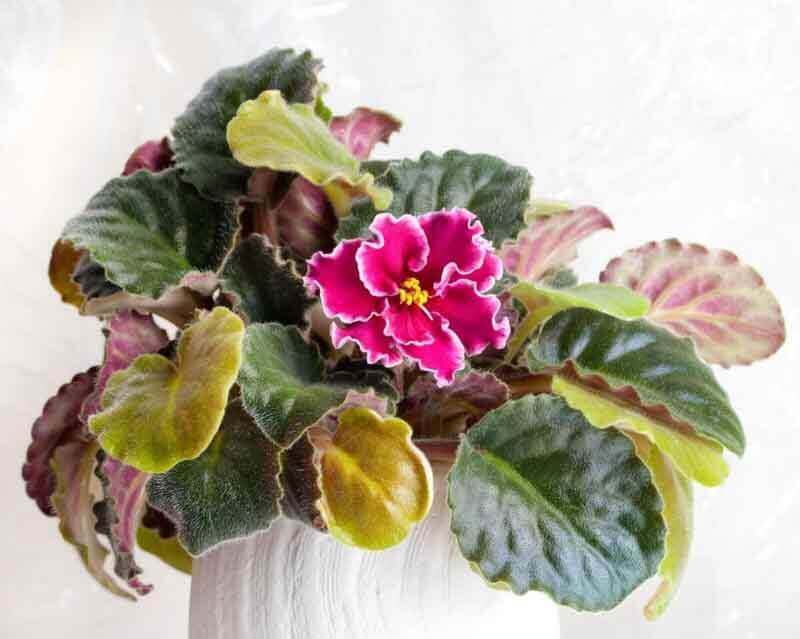
The first cause of African Violet leaf discoloration is over-watering. Over-watering causes the foliage to turn yellow, starting with the lower leaves and gradually spreading upwards.
The foliage will also become limp and lose its brittle texture. Another common cause is root rot, which causes the stem to turn mushy. Moreover, the soil will develop a murky smell. If you notice any of these symptoms, it’s time to change your plant’s soil.
Solution
One of the most common problems with African Violet plants is yellowing leaves. The condition is not unique to this species, though. A number of other plants, such as lilacs and roses, can also suffer from the same problem. If you notice your plants’ leaves turning yellow, there are several possible solutions.
First of all, you should check the soil. If the soil is too wet or too dry, African violets will not be able to absorb essential nutrients and water. You can also add epsom salts to your plant’s fertilizer and watering can to boost the soil’s nutrients. This will help the plant recover its energy levels, and will prevent the spread of pests.
Maybe you also like: 28+ Japanese Indoor Plants Beautiful Collections For Your Home
4. African Violet Leaves Drooping or Limp
African Violet leaves that are limping or drooping can be caused by many factors, including lack of water, sunlight, and fungus. You can prevent this by misting the plant every few days. It also helps if you keep it in an area where it does not receive direct sunlight. Using pebbles in the tray can also help to create the right microclimate for the plant.
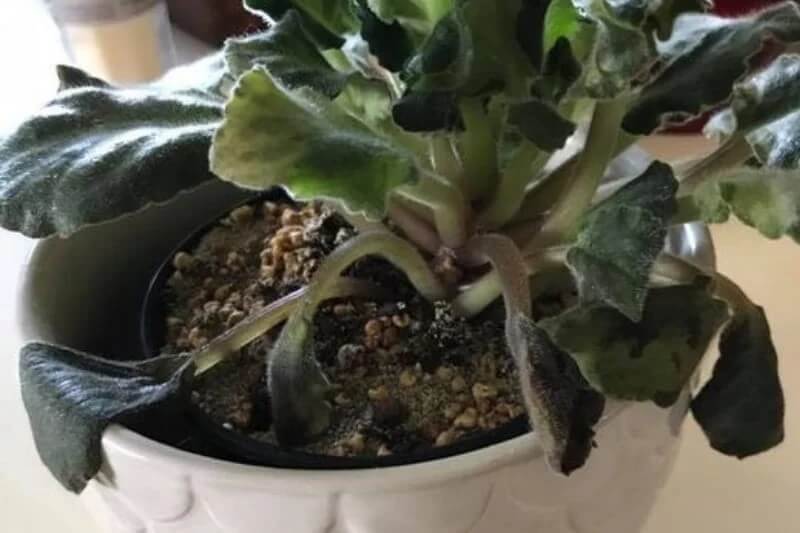
African violets prefer moist potting mix, and should be watered from both top and bottom. When watering, do not water too much or you’ll risk scorching the leaves. Also, try to use water that is lukewarm rather than cold, as cold water can harm the leaves. Also, try not to leave the plant in water for too long – watering too often may cause leaf spots.
African violet plants are sensitive to over-watering, and excessive moisture can result in root rot. This can lead to limping leaves, drooping leaves, and mushy soil. If this happens, you need to change your watering habits or move the plant to another container.
5. Brown Spots on African Violet Leaves
African violet leaves are susceptible to brown spots from a variety of causes. For instance, it may be afflicted with crown rot, a fungal disease caused by excessive watering or improper drainage. In severe cases, the plant may die. Other factors that can cause brown spots include improper watering and improper planting.
A sudden drop in temperature can cause brown spots on the plant’s leaves. This condition reduces photosynthesis and damages palisade cells, resulting in yellowing and fuzzy edges. In such cases, supplemental feeding will be necessary to get the plant back on track. Make sure to disinfect your containers before and after handling your plants.
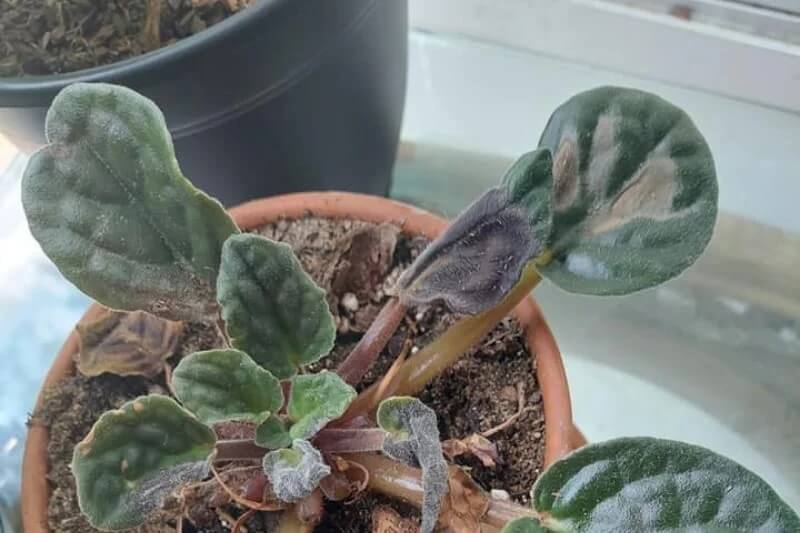
Poor air circulation is another common cause of brown spots on African violet leaves. In such cases, you should move your plant to an area with good air circulation. You should also open windows and doors to improve air circulation. In addition, make sure that there are no drafts entering your house as these can cause droopy leaves and brown spots.
Besides overwatering, bacterial blight is another potential cause of brown spots on African violet leaves. This bacterial infection affects leaves and causes them to turn yellow and brown. It is especially common in humid environments. It also affects the stem, causing it to become mushy.
Solution
African violet leaves may become infected with brown spots if they aren’t cleaned regularly. These spots are caused by a disease called bacterial leaf blight, caused by the bacterium Erwinia chrysanthemi.
The disease can be spread by humans and spider mites, and can kill the plant if it’s not treated in time. The best way to prevent the disease is to keep the surrounding area clean. Infected plants should be quarantined to prevent the spread of infection. You should also be careful to avoid overwatering and sudden temperature changes.
One way to treat the condition is by misting the leaves regularly. Misting the plants will help maintain a moist environment for them. If you are unable to mist them daily, you can keep them on a tray filled with moist pebbles. Alternatively, you can use an air humidifier.
Read more: 35+ Small Corner Rock Garden Ideas (Full image)
6. African Violet Leaves Turning White
If you have noticed that your African violet leaves are turning white, there are a number of possible causes. First, the plant is likely suffering from the fungal disease called powdery mildew. This can affect many plants, including African violets. Fortunately, you can treat this condition with neem oil.
Another common reason for the plant’s leaves turning white is an infestation of a root-knot nematode. This pest can attack the roots of the plant and deprive them of vital nutrients. The result of this attack is stunted growth and white leaves. The best way to deal with this problem is to separate the African violet from the other plants in your garden.

Another cause of African violet leaves turning white is excessive light. If the light is too bright, the plant will have difficulty producing chlorophyll. This means that the plant will need more light than unaffected foliage, which will reduce the amount of energy it can produce. However, lower light levels will encourage the growth of new green leaves. Ideally, the plant should be placed in a window that receives bright indirect sunlight.
Another problem that can lead to the plant’s leaves turning white is a root-knot nematode. This worm can spread from plant to plant and may even affect nearby plants. If you suspect this pest, you can spray neem oil over the affected area. This oil will kill the mites and the symptoms will go away.
7. Some other African violet leaf problems
Failure to flower is one of the most common problems that African violets face, but it doesn’t mean that the plant is doomed. There are other problems you might encounter, including petiole rot and water spots. To prevent or fix these problems, you need to know the proper ways to care for them.
Failure to Flower
In some cases, the African violet leaves may fail to open or flower. This may be caused by unfavorable environmental conditions, such as too-dry air and poor soil aeration. Low humidity can also affect the growth of African violets. If the flowers do not develop, the plant may drop.
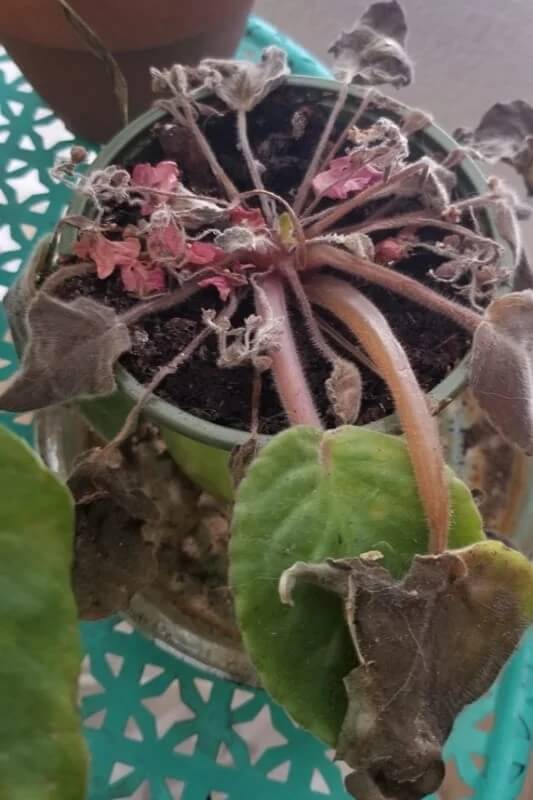
To prevent this problem, keep the plant well-watered. The soil should be moist but not soggy. Ensure that the soil is slightly acidic, but not too acidic. Moreover, it should not be too hot or cold for the plant. If the African violet plant is experiencing this problem, you should repot it in a larger container with better drainage.
Fertilizing is another way to avoid failure of African violet flowering. African violets need a moderate amount of phosphorus and potassium in the soil. It is best to use a liquid fertilizer with a mid-level strength. It should be added to the soil at least once a week.
Petiole Rot
Petiole rot is one of the most common problems that can strike African violets. This disease is caused by a buildup of fertilizer salts in the soil or pot rim. To prevent this from happening, wrap a piece of foil around the pot’s rim. Then, flush the container with fresh water. Aside from petiole rot, African violets are susceptible to a variety of diseases. Keeping your plants properly spaced and using sterilized soil can help prevent diseases.
Water Spots
Water spots on African violet leaf are the first sign of bacterial blight, which can cause the plant to die. This disease spreads rapidly and can affect the entire plant within five to seven days. Once an African violet leaf has been infected by this disease, it is not possible to cure it, and it must be discarded. The best way to prevent bacterial blight is to maintain a clean environment. It is important to sterilize your soil before planting to destroy pathogens, and to be extremely clean when you work with the plant.
To clean your African violet plant, you should gently blot the leaves and crown to remove excess water. Be careful not to rub or use too much pressure because the leaves of these plants are extremely delicate. It is also important not to use the tools for any other purpose. Always keep the tools exclusively for cleaning your plant.
Read more: The Best Window Plant Shelf You Should Try
How Do I Bring My African Violet Back to Life?
If your African violet is suffering from drought, you can bring it back to life by giving it a good watering. It can also be affected by low humidity or sunburn, so try to provide indirect light to your African violet. If you notice that its foliage has turned yellow, you may have overwatered it. In this case, you may need to repot it.
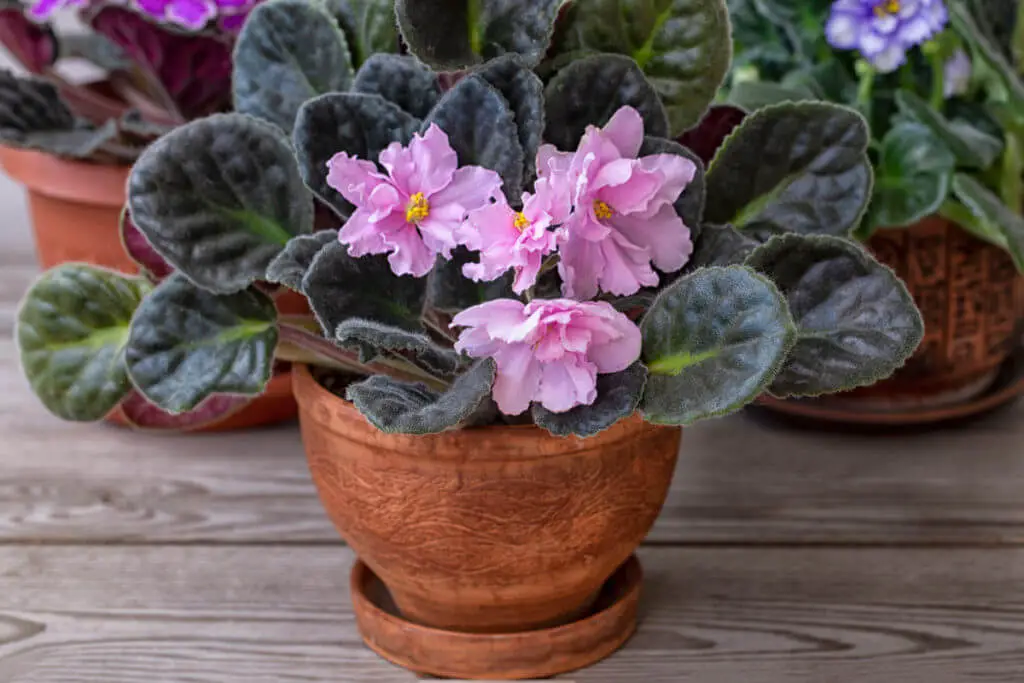
When you transplant an African violet, make sure you buy a pot that’s the right size for it. Make sure the pot is deep enough so that you can plant it in the soil. It’s also a good idea to repot it every six months. Make sure you use fresh soil and remember to water the plant adequately. Too much or too little watering can cause the plant to wilt and die.
Should I remove damaged leaves African violet?
African violets are susceptible to various pest infestations, including mites and mealybugs, which may cause stunted new growth. Affected leaves should be removed and replaced with fresh ones.
You can also treat your plant with a hydrogen peroxide solution, diluted with water. However, be sure to buy new potting soil to minimize the chance of reinfection. Once the plant is treated, leave it out overnight on a dry surface.
Conclusion
If you notice that your African violet is suffering from yellowing leaves, the first step is to check the root rot. This disease is caused by excessive watering, which encourages fungus growth. If you notice brown or mushy roots, these are signs of root rot. The plant will die if the roots become rotten. In order to save your plant from rot, you should cut off the rotten roots.
Read more:
How To Preserve Roses With Hairspray (6 Steps)
How to Clean Bamboo Floors – Important Notes.

